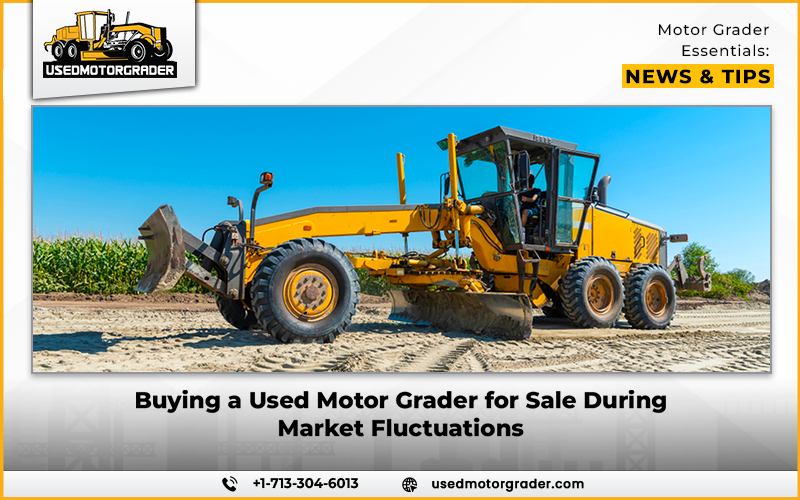Economic Highs and Lows: Why Timing Matters in Equipment Buying
Purchasing a used motor grader for sale is not only a matter of getting a good machine, but also a matter of timing. The building industry does not work in a vacuum. It responds to fuel prices, interest rates, spending on public infrastructure, and housing trends. Such changes percolate through equipment markets, altering prices, availability, and even financing terms. There is actual potential to make more intelligent, more opportune purchases by buyers who are aware of the larger economic cycle, particularly in terms of used graders.
Boom Periods: When Prices Climb with Demand
When the economy is experiencing a boom, the construction sector booms. The government money gets into the infrastructure, the private development gets going, and the contractors swell their fleets. That boom spurs the demand for new and used motor graders. Stocks become scarce, prices shoot up, and there is an increase in demand for low-hour units. The positive aspect is that this creates an expanding employment market and a greater economic well-being, but a buyer is likely to pay full price for equipment that would have been much cheaper only a year ago. It is an excellent time to sell off assets as a seller, but as a buyer, it is worth waiting and computing whether delaying a few months will be worth it.
Downturn Dynamics: When Fleet Sell-Offs Flood the Market
On the flip side, economic slowdowns create a very different dynamic. When construction slows, contractors downsize. Equipment that was once vital to a packed project calendar suddenly becomes surplus. The market sees an influx of used motor grader for sale models, many of them barely used, well-maintained, and available at a fraction of their new value. These downturn-driven sell-offs create a buyer’s market. There’s less competition, more options, and significantly more room to negotiate. Timing a purchase around these dips can result in serious savings and access to better equipment than your budget would typically allow.
Strategic Advantages of Buying During a Bust
For savvy buyers, a slow market is a gold mine. When demand drops, sellers become more flexible, and that can open doors to better warranties, bundled extras, or favorable financing. More importantly, you’ll likely find newer machines with lower hours, often sold by firms that maintained them meticulously to meet compliance and warranty standards. Buying during a downturn also lets buyers future-proof their fleet, acquiring assets affordably that they can put to use when the market rebounds. It’s not just about spending less, it’s about positioning for future work when competitors are still retooling.
Hidden Risks in Low-Cycle Acquisitions
Naturally, purchasing in a bust is not risk-free. Support services may contract when the overall market retreats. OEMs may reduce the dealer networks or availability of parts, and independent service providers may move to other sectors. That may complicate the process of obtaining repairs or maintenance parts. Then there is the resale value in the future. When there are too many identical models in the market, chances are that prices will remain low over a longer period than anticipated, and thereby you will not be able to sell the machine at a profit. The purchasers must ensure that they strike a balance between the bargain they are getting in the short term and the long-term factors, such as the availability of services and depreciation of assets.
Mid-Cycle Stability: A Safe Window for Long-Term Buyers
Many buyers love the middle of the cycle, when there is recovery going on, but not overheating. At this stage, demand has come back, but not in a very aggressive fashion. The prices are increasing, but not inflated. The sellers are more confident, yet they are ready to negotiate. It is during such times that buyers get a solid ground, good machines at reasonable prices, with good service facilities and funding that is not a gamble. This is usually the safest and most feasible time to take a step by contractors whose project pipelines are steady.
Financing and Interest Rate Considerations
Economic cycles don’t just affect used motor grader for sale availability. They directly influence the cost of money. When interest rates are high, borrowing gets more expensive, making even a great equipment deal harder to justify. Conversely, during times of low rates, financing a used motor grader becomes more attractive. But rate movements aren’t always tied to the health of the construction industry. Sometimes they’re a response to broader economic conditions. Buyers need to watch both the Fed and the field. A great grader deal paired with a high-interest loan can end up costing more than a higher-priced unit financed during a low-rate cycle.
Long-Term ROI and Exit Strategy Planning
Every purchase should come with an exit strategy. When considering a used motor grader, think beyond the upfront cost. What will this machine be worth in three, five, or seven years? Will it still meet emissions standards in your region? Will parts still be available? These are the questions that shape long-term return on investment. Buying with resale in mind, especially when aligned with broader market cycles, can lead to stronger profits or lower total cost of ownership. For contractors, the smartest grader purchases are those that fit both today’s project load and tomorrow’s market shifts.


